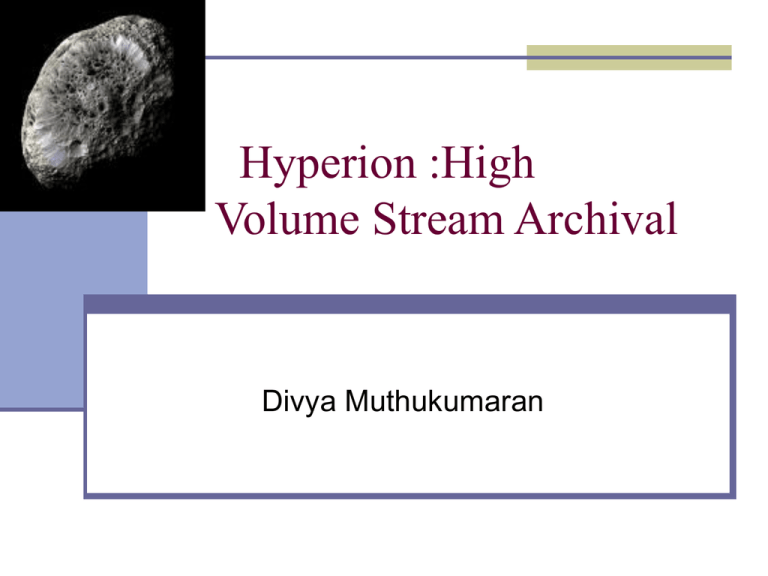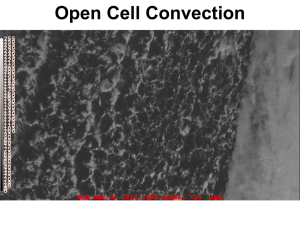Hyperion
advertisement

Hyperion :High Volume Stream Archival Divya Muthukumaran Area Network Monitoring Identify problems due to overloaded and/or crashed servers, network connections or other devices Example: To determine the status of a webserver, monitoring software may periodically send an HTTP request to fetch a page Live Monitoring Packets are examined in real time Compute and continually update traffic statistics Discard the captured packet headers once examined Why the need to store packet headers? Live Monitoring Packets are examined in real time Compute and continually update traffic statistics Discard the captured packet headers once examined Why the need to store packet headers? Example: Network forensics To go back and examine the root cause of a problem Ex: See how an intruder gained entry, How a worm infection happened What is the need of such a system? Querying and examining live data Data Archival Capture the data at wire speeds, Index and store them Efficiently support retrieval and processing of archived data Specifically designed to handle needs of high volume stream archival Why not traditional databases? Some statistics A single GB link can generate over 100,000 packets and tens of MBs of archival data. A monitor may record from Multiple links. Design Principles Support Queries not reads Implies the need to maintain indexes Writes Sequential and Immutable Archive locally , summarize globally Scalability Vs Need to avoid flooding Scalability: Favors local archiving and indexing to avoid network writes Need to answer Distributed queries: favors sharing information across nodes Hyperion Three Key components Stream File System High volume archiving and querying Multi-level index structure High update rates + reasonable lookup performance Distributed index layer Distributes a summary of local indices to enable distributed querying Design choices for the Hyperion Storage System Storage of multiple high-speed traffic streams without loss Support for concurrent read activity without loss of write performance Re-use of storage in a buffer-like fashion Stream File System Stores Streams as opposed to files Characteristics Recycled : When storage is full new data replaces old data. In a GP File system new data is lost old is retained Immutable Record-oriented: data is written in fixed or variable length records Can we use a GP FS? Need to map streams <=>files LogFile Rotation Stream FS Stream FS Organization Los-structured FS What problem? Cleaning/Garbage collection StreamFS solves the cleaning problem Guarantee : Storage guarantee for each stream Small segment size Check if next segment is a surplus . If yes then overwrite , otherwise skip. Stream FS Organization Los-structured FS What problem? Cleaning/Garbage collection StreamFS solves the cleaning problem stream Small segment size (1 or ½ MB) Guarantee : Storage guarantee for each Check if next segment is a surplus . If yes then overwrite , otherwise skip. Advantages? Storage Reservation Best effort use of remaining storage Reads First get index Use index to get data Persistent Handles Returned from each write operation Passed to read op to retrieve data What does the handle contain? Disk location , approximate length Allows data to be retrieved directly Handle issues Validate the handle. How? Self certifying record header Id of the stream Permissions of the stream Record length Hash (used for validating the handle) Stream FS Organization Record Variable length On-disk record + header Block Fixed length Multiple records of the same stream Block Map Every nth block (stream ID + in-stream sequence number for each of the preceding n-1 blocks) Used for easy write allocation Stream FS Organization Indexing Uses signature based Indices Signature for each segment Can check if a record with a key k is present in the segment or not Does not tell you where the record is present in the segment Multi-level Indices Multi Level Indices Uses a Bloom Filter Hash (key) -> b bits In b bits k bits are set to 1 = Hs (Signature) How to check for presence of a record? H(key1)||H(key2)…||H(keyn) Compute hash of its key kr, H(kr) If a bit in H(kr) is set but not set in Hs then the value is not present False positives Distributed Index How to handle distributed queries without flooding? Maintain distributed index Integrated view of all nodes Coarse-grain summary of data at each node is needed Can use the top level index in the Hyperion One index node per time interval All nodes send their top-level indices to this node Temporally–distributed index











